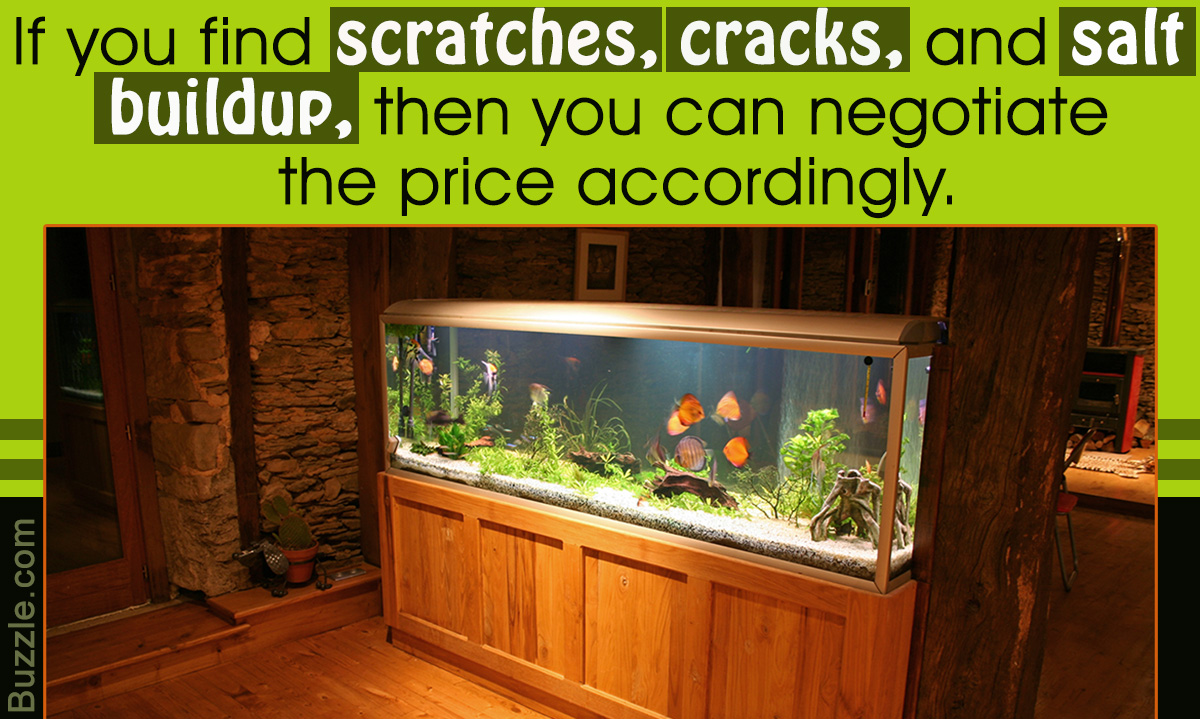
It is very necessary to evaluate a used aquarium by actually looking at it in person. Therefore, it is better to stay away from online shopping for used aquariums, because what you may see is not necessarily what you’ll get. Here’s a used aquarium buying guide to help you out.
Never use a terrarium as an aquarium, because terrariums are made up of glass that is much thinner than that of an aquarium, and may leak or break due to the prolonged pressure of water.
As long as the glass and frame are in good working condition, a used aquarium can give you the best bang for your bucks. So, before you set out in the market to become a used aquarium owner, read through the below-mentioned buying tips thoroughly.
Similar to any other buying process for used products, you have to set a clear picture of the amount of money you are ready to spend on the product. Therefore, the first thing to consider when buying a used aquarium is setting the budget.
You just cannot bring the aquarium, fill it with water, and put the fish in; you need all the accessories to make it beautiful and functional, right? Therefore, your set budget should be inclusive of all these additional bells and whistles.
Inspecting an Already-set and Running Aquarium
Leakages
This is perhaps the best situation you can be in. A setup and running aquarium can be easily checked for leakage. You can start by looking at the external wet surfaces. Run your fingers along the joints to see if there is any leakage. Sometimes, the leak can be very minor.
The next thing to observe is the sign of water damage on the stand or the floor. See if there is any particular spot that has become rusty or has got salt or hard water deposit. If you notice any wetness on the external surface, or any persistent water mark on the stand or floor, it is a sure-shot sign of a leak.
Usually, a leak is not that difficult to seal and can be done pretty cheaply. A 100% silicone sealant, which renders a waterproof seal can be used to stop the leakage.
Inspecting an Empty Aquarium
The Duration for Which It Was Kept Dry
First, you must ask the seller about the time duration for which the aquarium has been empty. This is important because the seals dry and shrink over time, which may lead to creation of leaks that were initially not present, but have developed due to prolonged storage.
Type of Fish That Were Last Kept
You should inquire about the type of fish that were last kept in the tank, or if any chemical treatment was done. This step is essential for your future fish, because some breeds of fish are sensitive to certain chemicals or even soap.
Integrity of the Frame
Start with checking the frame of the aquarium. If it has a cross support in the middle, check it thoroughly for integrity. The frame is usually provided as an extra support to the tank to bear the outward pressure that the water puts on the glass. If the frame is broken, it would be wiser not to choose the tank.
Water Leak Signs
You can look for water leak signs in a similar manner to that of a setup aquarium. Any white-colored stain of hard water salt deposit, along the seams and seals, is a clear indication that the aquarium was leaking in the past.
Integrity of the Silicone Seal
The next step is to check the silicone seal. Run your finger slowly across the seams. See if you can feel any rough, depressed, or any unusual patches. Also, observe if the silicone seal has started to pull away, leaving the joints open. I would advise you to slide your finger slowly because if any chip or crack is present, you may unknowingly hurt yourself.
After that, you have to observe the silicone bond carefully. Too many air bubbles in the bonded space is a sign that the tank has the potential to lose integrity and start leaking. But it is not a major concern because resealing of the tank can be done very easily.
Cracks
If the seller is giving away the tank that has a crack, and you are ready to get it fixed, then it is highly recommended that you negotiate to lower the price to a great extent. Normally, the glass pane that has the crack has to be replaced with a new pane. You can think of sealing it with a silicone sealant, but the end result would be clearly visible. Also, there is no guarantee that the ‘patch job’ will be a permanent solution.
Chipped Glass
Chipped edges don’t look good from an aesthetic point of view. Also, if the chipping has occurred near the seams, it makes the tank susceptible to leakage. Therefore, it would be reasonable to avoid purchasing tanks that have big cracks and large chipped areas. It totally depends on your willingness to get it repaired.
Scratches
Scratches on the glass surface are an unavoidable part of normal wear and tear. Therefore, as long as the scratches are only a few and not so visible, you can go ahead with the purchase.
Ask to Fill Up the Tank
After you observe the empty tank, ask the seller to fill it up. There are two reasons for this: (i) unless you fill up a tank, it is difficult to spot leaks. Sometimes the leaks are minute, and it may take time for water to show out from the leaking area; (ii) the mineral buildup or salt deposits become less visible after filling water.
In opposition to it, the scratches become more clearly visible after filling up water. If you place a source of light above the filled tank, the cracks would also become visible.
Single Unit or With Accessories
You can also inquire if he/she is only going to sell the aquarium as a single unit, or will he/she give the accessories also.
After considering all the above-mentioned points, contemplate on the damages and attempt to determine a solution for it. If it can be made as good as new with a few minor replacements here and there, don’t miss the opportunity. I can assure you that buying used items will often result in considerable amount of savings. Therefore, seal the deal, and take the tank home.





